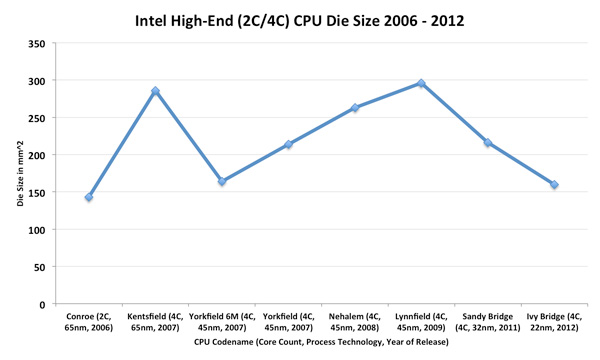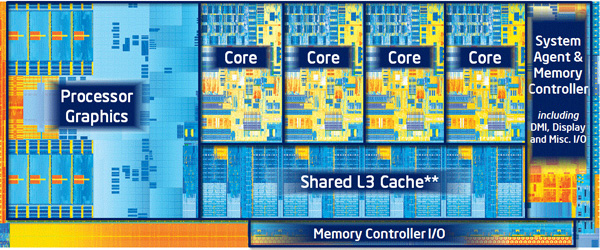The Intel Ivy Bridge (Core i7 3770K) Review
by Anand Lal Shimpi & Ryan Smith on April 23, 2012 12:03 PM EST- Posted in
- CPUs
- Intel
- Ivy Bridge
Die Size and Transistor Count
At IDF last year we got word of Ivy Bridge's transistor count (1.4 billion), however today we know its die size: 160mm2. That's 75% the size of a quad-core Sandy Bridge, but with 20% more transistors.
This marks the first time since 2006 that Intel is offering a high-end desktop CPU with this small of a die size. I'm excluding the 6-core parts from the discussion since that line isn't really aimed at the same market anymore. The chart is even more insane when you consider the Ivy Bridge die size includes an integrated GPU alongside four of the highest performance x86 cores Intel has ever shipped. Remove the GPU and Ivy Bridge is even smaller than Conroe. A hypothetical GPU-less Ivy Bridge would measure in at roughly 113mm^2 chip on its 22nm process, making it smaller than any high-end Intel CPU since the days of the Pentium 3.
| CPU Specification Comparison | ||||||||
| CPU | Manufacturing Process | Cores | Transistor Count | Die Size | ||||
| AMD Bulldozer 8C | 32nm | 8 | 1.2B | 315mm2 | ||||
| Intel Ivy Bridge 4C | 22nm | 4 | 1.4B | 160mm2 | ||||
| Intel Sandy Bridge E (6C) | 32nm | 6 | 2.27B | 435mm2 | ||||
| Intel Sandy Bridge E (4C) | 32nm | 4 | 1.27B | 294mm2 | ||||
| Intel Sandy Bridge 4C | 32nm | 4 | 1.16B | 216mm2 | ||||
| Intel Lynnfield 4C | 45nm | 4 | 774M | 296mm2 | ||||
| Intel Sandy Bridge 2C (GT1) | 32nm | 2 | 504M | 131mm2 | ||||
| Intel Sandy Bridge 2C (GT2) | 32nm | 2 | 624M | 149mm2 | ||||
Ivy Bridge is tiny—but what does this mean? For starters, it means the obvious—Intel has little competition in the desktop space. I'm always hard on AMD in my meetings with them because of this reason alone. A less than competitive AMD means we get a less aggressive Intel.
More importantly however, a tiny Ivy means that Intel could have given us a much bigger GPU without breaking the bank. I hinted at this possibility in our Ivy Bridge architecture article. Unfortunately at the time only Apple was interested in a hypothetical Ivy Bridge GT3 and rumor has it that Otellini wasn't willing to make a part that only one OEM would buy in large quantities. We will eventually get the GPU that Apple wanted, but it'll be next year, with Haswell GT3. And the GPU that Apple really really wanted? That'll be GT4, with Broadwell in 2014.
All of this being said however, we must keep in mind that Ivy Bridge is both faster than Sandy Bridge and no more expensive. If we look at the supply and pricing constraints that accompany TSMC's 28nm process, the fact that Intel is able to ramp up 22nm and ship the first products without any price increase is something we shouldn't take for granted.












173 Comments
View All Comments
wingless - Monday, April 23, 2012 - link
I'll keep my 2600K.....just kidding
formulav8 - Monday, April 23, 2012 - link
I hope you give AMD even more praise when Trinity is released Anand. IMO you way overblew how great Intels igp stuff. Its their 4th gen that can't even beat AMDs first gen.Just my opinion :p
Zstream - Monday, April 23, 2012 - link
I agree..dananski - Monday, April 23, 2012 - link
As much as I like the idea of decent Skyrim framerates on every laptop, and even though I find the HD4000 graphics an interesting read, I couldn't care less about it in my desktop. Gamers will not put up with integrated graphics - even this good - unless they're on a tight budget, in which case they'll just get Llano anyway, or wait for Trinity. As for IVB, why can't we have a Pentium III sized option without IGP, or get 6 cores and no IGP?Kjella - Tuesday, April 24, 2012 - link
Strategy, they're using their lead in CPUs to bundle it with a GPU whether you want it or not. When you take your gamer card out of your gamer machine it'll still have an Intel IGP for all your other uses (or for your family or the second-hand market or whatever), that's one sale they "stole" from AMD/nVidia's low end. Having a separate graphics card is becoming a niche market for gamers. That's better for Intel than lowering the expectation that a "premium" CPU costs $300, if you bring the price down it's always much harder to raise it again...Samus - Tuesday, April 24, 2012 - link
As amazing this CPU is, and how much I'd love it (considering I play BF3 and need a GTX560+ anyway) I have to agree the GPU improvement is pretty disappointing...After all that work, Intel still can't even come close to AMD's integrated graphics. It's 75% of AMD's performance at best.
Cogman - Thursday, May 3, 2012 - link
There is actually a good reason for both AMD and Intel to keep a GPU on their CPUs no matter what. That reason is OpenCV. This move makes the assumption that OpenCV or programming languages like it will eventually become mainstream. With a GPU coupled to every CPU, it saves developers from writing two sets of code to deal with different platforms.froggr - Saturday, May 12, 2012 - link
OpenCV is Open Computer Vision and runs either way. I think you're talking about OpenCL (Open Compute Language). and even that runs fine without a GPU. OpenCL can use all cores CPU + GPU and does not require separate code bases.OpenCL runs faster with a GPU because it's better parallellized.
frozentundra123456 - Monday, April 23, 2012 - link
Maybe we could actually see some hard numbers before heaping so much praise on Trinity??I will be convinced about the claims of 50% IGP improvements when I see them, and also they need to make a lot of improvements to Bulldozer, especially in power consumption, before it is a competitive CPU. I hope it turns out to be all the AMD fans are claiming, but we will see.
SpyCrab - Tuesday, April 24, 2012 - link
Sure, Llano gives good gaming performance. But it's pretty much at Athlon II X4 CPU performance.